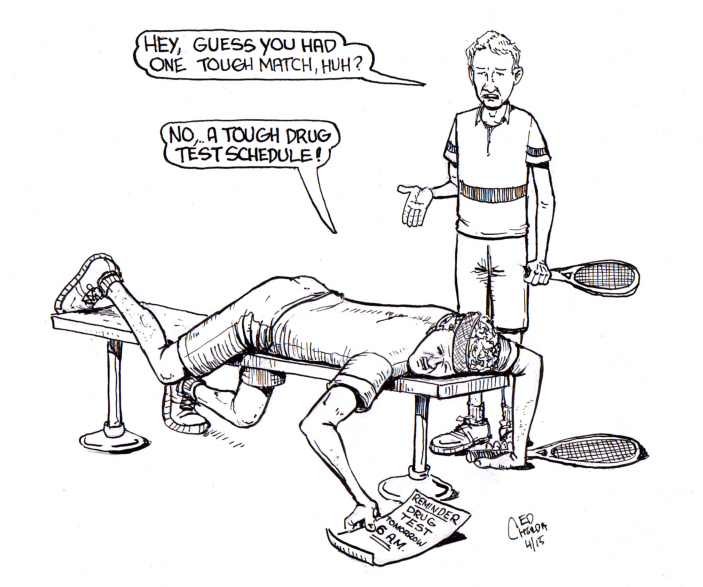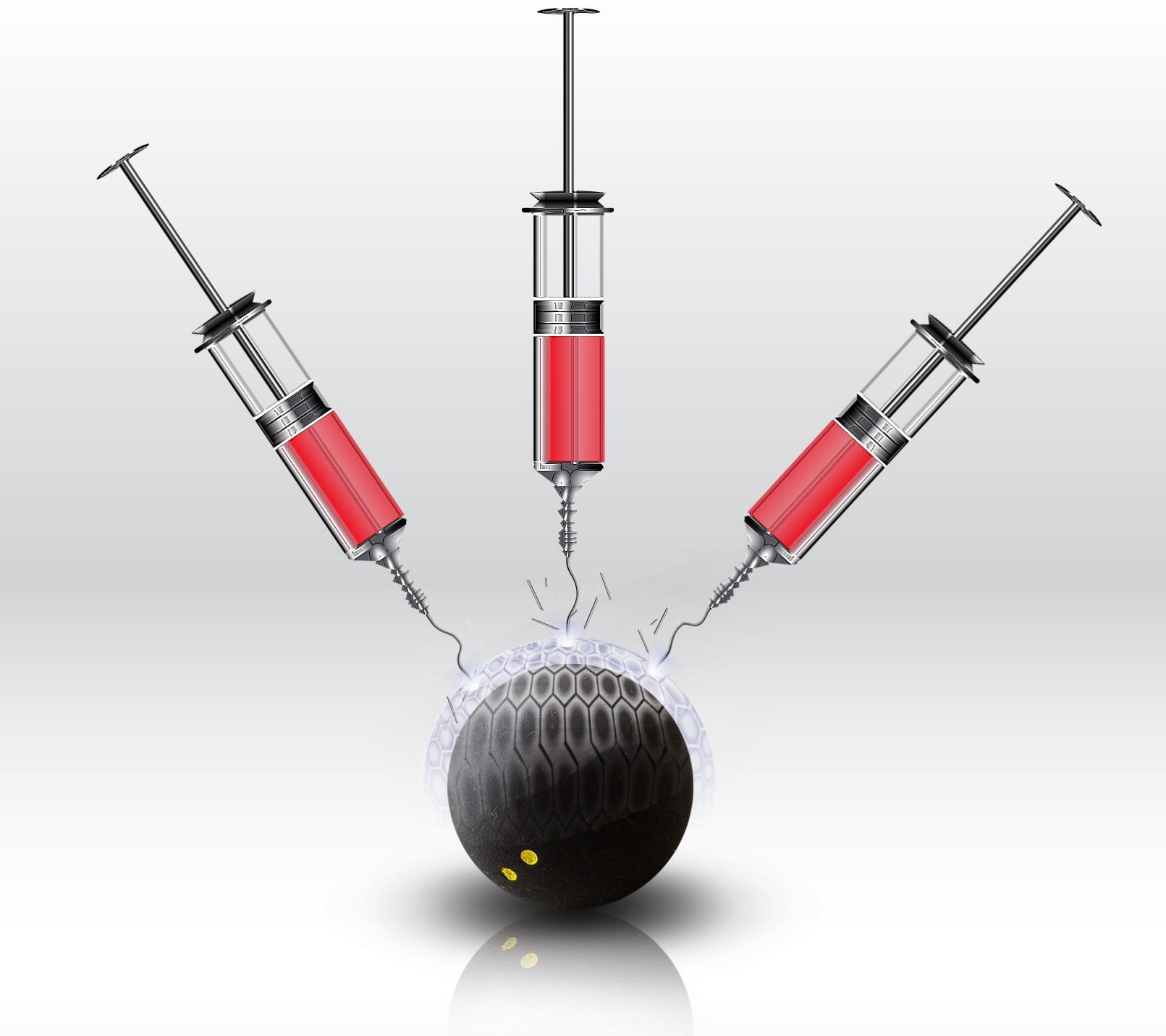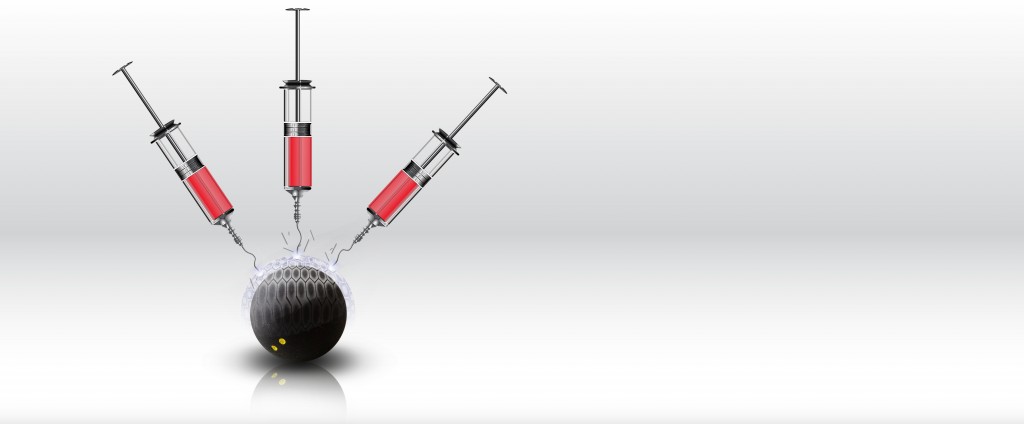Squash is one of the cleanest sports in the world. Only twenty professionals have been suspended in the history of testing.
Drilling down into these positive tests, one sees a few facts. Although some players whisper about rumors of failed tests among players of certain developing countries—Egypt, Pakistan the ones most mentioned—the World Squash Federation statistics tell another story. Fifteen of the twenty are from Europe, including six from France and five from Belgium; three are women.
Fourteen of the twenty were caught taking a cannabinoid, in all the squash cases it was marijuana; four were doing a stimulant which was either an amphetamine, cocaine or ephedrine (which is found in some cold/flue remedies); one was for furosemide, a diuretic (an odd thing for a squash player to take, as losing a pound or two of fluid doesn’t improve your game); and one—just one—was prednisone, a corticosteroid. So just one player caught using steroids (and the wrong kind of steroids at that, as it is not nearly as effective at building muscle mass as a testosterone steroid).
Squash is clean in part because there is so little money, comparatively, in the game. Players don’t have enough of an incentive to cheat and they don’t have enough money to pay for the drugs and the administrators of the drugs (consider the staff that helped Lance Armstrong cheat). Squash layers universally scorn doping. “You put something in, you take something out,” said Shabana. “You add something to your system like that, you are going to reduce something else. This is too complex a game.” Would some things help recovery during a long tournament week? Would a return from an injury be speeded up? Yes, but the uniquely combined twin aspects of squash—the fast-twitch sprinting, turning and twisting and the endurance—make it a very hard game to dope.
Moreover, it is hard to get away with doping in squash. Only one of the twenty suspended players has reached the world top forty—these are all third-tier journeymen or youngsters low down on the totem pole.
Squash has been testing for twenty-five years. It began in 1989. In the aftermath of the Ben Johnson doping scandal at the 1988 Olympics, testing quietly came into squash via a Canadian. Norm Gledhill, a kinesiologist at York University, played squash at the Toronto Cricket Club and his two sons were active junior players, playing for both Ontario and Canada at the youth level (one went on to play at the University of Western Ontario). Gledhill fell into anti-doping—his main field is studying requirements for physically-demanding jobs like firefighters and police officers—in part because he had done the initial research in the 1980s that proved that blood doping worked (there had been no definitive evidence before Gledhill that it did actually work).

“It was all serendipity,” Gledhill said. “One thing just led to another.” In 1984 he founded and chaired the Committee on Doping in Amateur Sport in Canada. A year later he chaired the Medical Scientific Committee of Squash Canada. This led to him making a presentation at the WSF’s annual general meeting in 1989 and becoming the first chair of the WSF Medical Scientific Committee. As the WSF looked into getting into the Olympic movement (the late 1980s was when squash was joining the Pan-Am and Commonwealth Games), having a bona fide anti-doping regimen was a requirement.
At the 1989 World Open in Kuala Lumpur in October, Gledhill organized the first-ever testing of men. He tested Chris Dittmar and Jansher Khan after their final (Khan won 15-10 in the fifth). “It was quite an odd situation,” Gledhill said. “We had to sit there and wait until the players were hydrated enough to go the bathroom. Dittmar started drinking beers and telling stories. Jansher was a bit more prickly—he wasn’t that pleasant about the whole thing.”
In the early 1990s, Canada gave squash a second volunteer. A hematologist, Anne Smith grew up in Scotland and in 1983 immigrated to Canada, where she rose up in the Canadian squash ranks. In 1989 she became the president of Squash Canada as well as a vice president of the WSF.
“It was very rudimentary in the early 1990s,” said Smith. “I became heavily involved in helping Norm and, after he stepped down in 1993, I took over chairing the Medical Scientific Committee. We slowly got it to where all world championships had testing. That was in 1994. In 1995 we had testing at the Pan-Am Games. At the time it was just certain steroids we could test for. I think a few players at the world juniors tested positive because they had taken cold medicine.”
The original program was modeled after the Canadian anti-doping policy but it was focused entirely on testing at WSF world championship events. A few players tested positive—for cold medicine violations not performance enhancing drugs—but because there was no world-wide governing body with one universal procedure for handling positive tests, players were fined by their own national association and very often the WSF would not even be told.
In 1999 the World Anti-Doping Agency was launched. In 2001 the WSF adopted the WADA code, and in April 2004 the men’s and women’s pro associations agreed to a joint program. “Before that the PSA and WSA didn’t have a lot of buy-in,” said Smith, who US Squash honored with the W. Stewart Brauns, Jr. Award in 1994. “They rather wanted to put money into prize money. But we had to be compliant with WADA. If a sport wasn’t compliant with WADA, there was absolutely no hope of getting into the Olympics.”
Over the years, the program evolved (Smith was not involved from 1999 to 2006 when Geraldine Bonneville, an Irishwoman, ran the program). In 2007 the WSF created a separate anti-doping commission. In 2009, following WADA’s new rules that year, the WSF adopted the “whereabouts” program, where athletes would randomly be tested out of competition (when most doping occurs) and they, therefore, had to tell the WSF where they would be for an hour each day.
WADA then pushed squash to test more—in 2011 they reviewed the WSF program and declared it non-compliant because there were too few athletes being tested. The WSF made changes. It began to add blood testing on top of urine sampling.
In January 2015 entirely new criteria was instituted. Each player now has a biological passport, so enormous changes in the level of something can be detected. (Early on in the testing, Julien Bonetat tested positive but, after he vociferously protested, further testing revealed that he just naturally had a high-level of testerone in his body.) The WSF testing pool before 2015 was purely a numbers game: a fifty-fifty split between men and women; every player in the top ten; and a random selection of five men and five women ranked from world No. 11 to 30. Beginning in 2015, the WSF could look at players who were coming back from injury, players from countries where the testing program was not strong—some countries have very rigorous programs for squash players, others not so much. The 2015 program now had two pools: eight men from the top forty and four women from the top thirty in one pool and then ten other players in a second pool. The pools shift every three months based on the world rankings.
The WSF spends about $20,000 a year on testing. Lorraine Harding, the WSF operations manager, manages the program. On staff since 1996 (she came from the British Chess Federation), she has worked diligently to maintain WADA standards. Every year Harding and White attend WADA’s annual conference in Lausanne. “I would say we are a clean sport,” said Anne Smith. “We have done good, regular testing. To date, we are clean. Squash is clean. Most of what we do is absolutely mandatory. The meat of it is all WADA. We don’t have much flexibility. We’d like to put more money into it. We’d like to have a WSF staffer solely focused on doping. But for now, we are proud of our program.”
Testing is not fun or for the faint-hearted. It takes a fair amount of reading and translating to understand what is illegal. The WSF code is fifty-one pages; the list of prohibited substances runs for ten pages and includes dozens of names you’ve never heard of—it makes reading the ingredients in a box of Twinkies seem like child’s play. Players are allowed to miss three tests in twelve months but after one missed test, almost all never miss a second.
“The testing is intrusive,” said Rachael Grinham. “There isn’t a lot of privacy. You basically have to get naked in the bathroom, so the tester can be sure you aren’t sneaking someone else’s urine into the sample.” Being on whereabouts, it limits your flexibility—that cutie at the other end of the bar, you can’t go back to their place—and means an early wake-up. Those on the whereabouts list usually give the 6am-7am time slot as the one they will know where they will be each day.
If it is during a tournament, testing can wreak havoc on sleeping schedules, both for the player being tested and their roommate. Once at the start of the 2014 Delaware Investments U.S. Open, Mohamed Elshorbagy was super annoyed about being hauled out of bed at 6am to get tested. “But when I got down to the lobby,” he said, “there were a half dozen players there—Aisling Blake, Sarah-Jane Perry and so forth—so I didn’t feel as badly. But I couldn’t go back to sleep after.” Roommates get woken up, too. “My parents were staying with me one year in New York at the Tournament of Champions,” said Camille Serme. “They called at 7am and wake everyone up in the room and my father answers the phone. The woman is like, ‘I need to talk to Camille,’ and my father is like, ‘Who is this? What is your name? Why are you calling my daughter at this hour?’”
Hotels or billets, the problem is the same. “I was staying with a friend during the Carol Weymuller in Brooklyn,” said Jenny Duncalf, “and it was the only day I had all week for a lie-in. Suddenly, there is this banging on the door at 6am and my billet goes to answer it and the tester says something about drug testing and my billet—it is very early and she’s a bit foggy, says, ‘Oh, no, not my Jenny. She doesn’t do drugs. You’ve got the wrong place.’”
Testing can interrupt meals—many players talk about testers coming in just as they are sitting down to dinner. Testing is tricky when you are having surgery or even just a nasty cold; players can ask for what is called a Therapeutic Use Exemption in advance, so they can take something that might otherwise be prohibited.
Players say testing can affect performance because of post-match disruption. At the 2009 British Open in Manchester, every men’s quarterfinalist got tested. Amr Shabana, the four-time world champion, survived a massive, eighty-six minute battle, 19-17 in the fourth, with David Palmer. “I knew they were coming to get me, like all the quarterfinalists, so I waited and waited courtside after the match,” Shabana said. “After about five minutes, no one was there, and so I went to the locker room and pissed and took a shower. When I got out of the shower, they were there.” Shabana patiently hydrated and started drinking beer to get him closer to urination. “It took hours and by the time I got back to the hotel it was very late.” The next day he lost 3-0 to James Willstrop in half an hour.
Last year at the 2014 Commonwealth Games, Nick Matthew was tested after winning the gold medal. “It was horribly anti-climatic,” remembered Lorraine Harding. “He had his medal around his neck but had to sit and wait until he could give the sample. Not a soul about, just the tester. He wanted to go off and celebrate, see his family and friends, the rest of the England team, fans.”
It is perhaps simply the price you pay for being a professional athlete .






